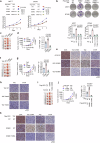Nucleus-translocated glucokinase functions as a protein kinase to phosphorylate TAZ and promote tumour growth
- PMID: 40759645
- PMCID: PMC12322040
- DOI: 10.1038/s41467-025-62566-4
Nucleus-translocated glucokinase functions as a protein kinase to phosphorylate TAZ and promote tumour growth
Abstract
Hypoxia frequently occurs during rapid tumour growth. However, how tumour cells adapt to hypoxic stress by remodeling central cellular pathways remains largely unclear. Here, we show that hypoxia induces casein kinase 2 (CK2)-mediated glucokinase (GCK) S398 phosphorylation, which exposes its nuclear localization signal (NLS) for importin α1 binding and nuclear translocation. Importantly, nuclear GCK interacts with the transcriptional coactivator with PDZ-binding motif (TAZ) and functions as a protein kinase that phosphorylates TAZ T346. Phosphorylated TAZ recruits peptidyl-prolyl cis-trans isomerase NIMA-interacting 1 (PIN1) for cis-trans isomerization of TAZ, which inhibits the binding of β-TrCP to TAZ and β-TrCP-mediated TAZ degradation. Activated TAZ-TEAD induces the expression of downstream target genes to promote tumour growth. These findings reveal an instrumental mechanism by which a glycolytic enzyme regulates the Hippo pathway under hypoxic conditions and highlight the moonlighting function of GCK as a protein kinase in modulating TAZ activity and tumour growth.
© 2025. The Author(s).
Conflict of interest statement
Competing interests: Z.L. owns shares in Signalway Biotechnology (Pearland, TX), which supplied the rabbit antibodies that recognize GCK pS398 and TAZ pT346. Z.L.’s interest in this company had no bearing on its being chosen to supply these reagents. The remaining authors declare no competing interests.
Figures






References
-
- Lu, B., Munoz-Gomez, M. & Ikeda, Y. The two major glucokinase isoforms show conserved functionality in beta-cells despite different subcellular distribution. Biol. Chem.399, 565–576 (2018). - PubMed
-
- Bian, X. et al. Regulation of gene expression by glycolytic and gluconeogenic enzymes. Trends Cell Biol.32, 786–799 (2022). - PubMed
MeSH terms
Substances
LinkOut - more resources
Full Text Sources
Medical
Miscellaneous

